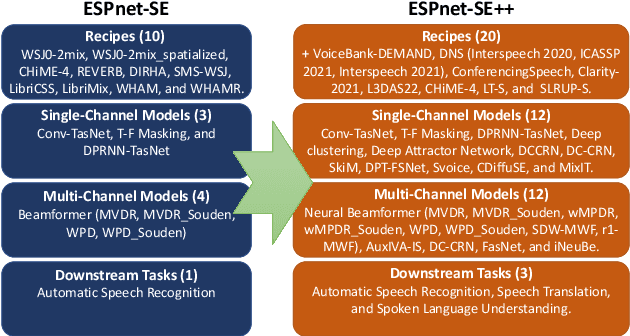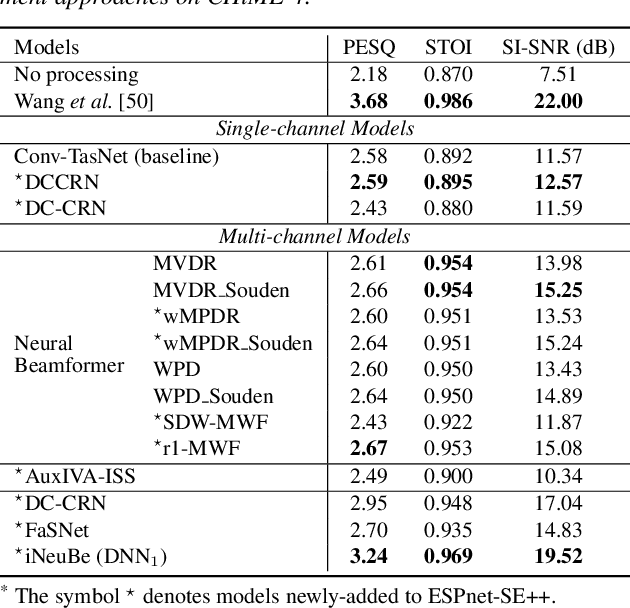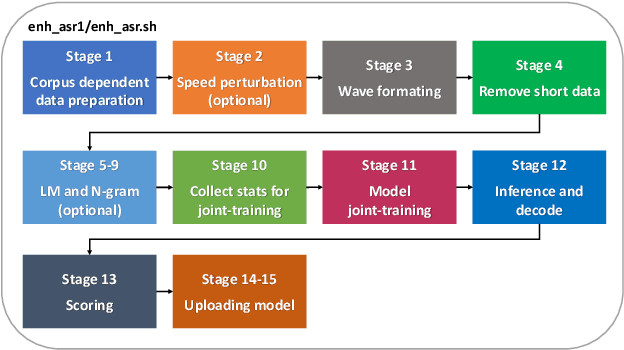Chenda Li
Improving Speech Enhancement with Multi-Metric Supervision from Learned Quality Assessment
Jun 13, 2025Abstract:Speech quality assessment (SQA) aims to predict the perceived quality of speech signals under a wide range of distortions. It is inherently connected to speech enhancement (SE), which seeks to improve speech quality by removing unwanted signal components. While SQA models are widely used to evaluate SE performance, their potential to guide SE training remains underexplored. In this work, we investigate a training framework that leverages a SQA model, trained to predict multiple evaluation metrics from a public SE leaderboard, as a supervisory signal for SE. This approach addresses a key limitation of conventional SE objectives, such as SI-SNR, which often fail to align with perceptual quality and generalize poorly across evaluation metrics. Moreover, it enables training on real-world data where clean references are unavailable. Experiments on both simulated and real-world test sets show that SQA-guided training consistently improves performance across a range of quality metrics.
Interspeech 2025 URGENT Speech Enhancement Challenge
May 29, 2025Abstract:There has been a growing effort to develop universal speech enhancement (SE) to handle inputs with various speech distortions and recording conditions. The URGENT Challenge series aims to foster such universal SE by embracing a broad range of distortion types, increasing data diversity, and incorporating extensive evaluation metrics. This work introduces the Interspeech 2025 URGENT Challenge, the second edition of the series, to explore several aspects that have received limited attention so far: language dependency, universality for more distortion types, data scalability, and the effectiveness of using noisy training data. We received 32 submissions, where the best system uses a discriminative model, while most other competitive ones are hybrid methods. Analysis reveals some key findings: (i) some generative or hybrid approaches are preferred in subjective evaluations over the top discriminative model, and (ii) purely generative SE models can exhibit language dependency.
Scale This, Not That: Investigating Key Dataset Attributes for Efficient Speech Enhancement Scaling
Dec 19, 2024



Abstract:Recent speech enhancement models have shown impressive performance gains by scaling up model complexity and training data. However, the impact of dataset variability (e.g. text, language, speaker, and noise) has been underexplored. Analyzing each attribute individually is often challenging, as multiple attributes are usually entangled in commonly used datasets, posing a significant obstacle in understanding the distinct contributions of each attribute to the model's performance. To address this challenge, we propose a generation-training-evaluation framework that leverages zero-shot text-to-speech systems to investigate the impact of controlled attribute variations on speech enhancement performance. It enables us to synthesize training datasets in a scalable manner while carefully altering each attribute. Based on the proposed framework, we analyze the scaling effects of various dataset attributes on the performance of both discriminative and generative SE models. Extensive experiments on multi-domain corpora imply that acoustic attributes (e.g., speaker and noise) are much more important to current speech enhancement models than semantic attributes (e.g., language and text), offering new insights for future research.
Diffusion-based Generative Modeling with Discriminative Guidance for Streamable Speech Enhancement
Jun 19, 2024

Abstract:Diffusion-based generative models (DGMs) have recently attracted attention in speech enhancement research (SE) as previous works showed a remarkable generalization capability. However, DGMs are also computationally intensive, as they usually require many iterations in the reverse diffusion process (RDP), making them impractical for streaming SE systems. In this paper, we propose to use discriminative scores from discriminative models in the first steps of the RDP. These discriminative scores require only one forward pass with the discriminative model for multiple RDP steps, thus greatly reducing computations. This approach also allows for performance improvements. We show that we can trade off between generative and discriminative capabilities as the number of steps with the discriminative score increases. Furthermore, we propose a novel streamable time-domain generative model with an algorithmic latency of 50 ms, which has no significant performance degradation compared to offline models.
URGENT Challenge: Universality, Robustness, and Generalizability For Speech Enhancement
Jun 07, 2024



Abstract:The last decade has witnessed significant advancements in deep learning-based speech enhancement (SE). However, most existing SE research has limitations on the coverage of SE sub-tasks, data diversity and amount, and evaluation metrics. To fill this gap and promote research toward universal SE, we establish a new SE challenge, named URGENT, to focus on the universality, robustness, and generalizability of SE. We aim to extend the SE definition to cover different sub-tasks to explore the limits of SE models, starting from denoising, dereverberation, bandwidth extension, and declipping. A novel framework is proposed to unify all these sub-tasks in a single model, allowing the use of all existing SE approaches. We collected public speech and noise data from different domains to construct diverse evaluation data. Finally, we discuss the insights gained from our preliminary baseline experiments based on both generative and discriminative SE methods with 12 curated metrics.
Beyond Performance Plateaus: A Comprehensive Study on Scalability in Speech Enhancement
Jun 06, 2024



Abstract:Deep learning-based speech enhancement (SE) models have achieved impressive performance in the past decade. Numerous advanced architectures have been designed to deliver state-of-the-art performance; however, their scalability potential remains unrevealed. Meanwhile, the majority of research focuses on small-sized datasets with restricted diversity, leading to a plateau in performance improvement. In this paper, we aim to provide new insights for addressing the above issues by exploring the scalability of SE models in terms of architectures, model sizes, compute budgets, and dataset sizes. Our investigation involves several popular SE architectures and speech data from different domains. Experiments reveal both similarities and distinctions between the scaling effects in SE and other tasks such as speech recognition. These findings further provide insights into the under-explored SE directions, e.g., larger-scale multi-domain corpora and efficiently scalable architectures.
SpeechComposer: Unifying Multiple Speech Tasks with Prompt Composition
Jan 31, 2024Abstract:Recent advancements in language models have significantly enhanced performance in multiple speech-related tasks. Existing speech language models typically utilize task-dependent prompt tokens to unify various speech tasks in a single model. However, this design omits the intrinsic connections between different speech tasks, which can potentially boost the performance of each task. In this work, we propose a novel decoder-only speech language model, SpeechComposer, that can unify common speech tasks by composing a fixed set of prompt tokens. Built upon four primary tasks -- speech synthesis, speech recognition, speech language modeling, and text language modeling -- SpeechComposer can easily extend to more speech tasks via compositions of well-designed prompt tokens, like voice conversion and speech enhancement. The unification of prompt tokens also makes it possible for knowledge sharing among different speech tasks in a more structured manner. Experimental results demonstrate that our proposed SpeechComposer can improve the performance of both primary tasks and composite tasks, showing the effectiveness of the shared prompt tokens. Remarkably, the unified decoder-only model achieves a comparable and even better performance than the baselines which are expert models designed for single tasks.
Adapting Multi-Lingual ASR Models for Handling Multiple Talkers
May 30, 2023



Abstract:State-of-the-art large-scale universal speech models (USMs) show a decent automatic speech recognition (ASR) performance across multiple domains and languages. However, it remains a challenge for these models to recognize overlapped speech, which is often seen in meeting conversations. We propose an approach to adapt USMs for multi-talker ASR. We first develop an enhanced version of serialized output training to jointly perform multi-talker ASR and utterance timestamp prediction. That is, we predict the ASR hypotheses for all speakers, count the speakers, and estimate the utterance timestamps at the same time. We further introduce a lightweight adapter module to maintain the multilingual property of the USMs even when we perform the adaptation with only a single language. Experimental results obtained using the AMI and AliMeeting corpora show that our proposed approach effectively transfers the USMs to a strong multilingual multi-talker ASR model with timestamp prediction capability.
Target Sound Extraction with Variable Cross-modality Clues
Mar 15, 2023



Abstract:Automatic target sound extraction (TSE) is a machine learning approach to mimic the human auditory perception capability of attending to a sound source of interest from a mixture of sources. It often uses a model conditioned on a fixed form of target sound clues, such as a sound class label, which limits the ways in which users can interact with the model to specify the target sounds. To leverage variable number of clues cross modalities available in the inference phase, including a video, a sound event class, and a text caption, we propose a unified transformer-based TSE model architecture, where a multi-clue attention module integrates all the clues across the modalities. Since there is no off-the-shelf benchmark to evaluate our proposed approach, we build a dataset based on public corpora, Audioset and AudioCaps. Experimental results for seen and unseen target-sound evaluation sets show that our proposed TSE model can effectively deal with a varying number of clues which improves the TSE performance and robustness against partially compromised clues.
ESPnet-SE++: Speech Enhancement for Robust Speech Recognition, Translation, and Understanding
Jul 19, 2022



Abstract:This paper presents recent progress on integrating speech separation and enhancement (SSE) into the ESPnet toolkit. Compared with the previous ESPnet-SE work, numerous features have been added, including recent state-of-the-art speech enhancement models with their respective training and evaluation recipes. Importantly, a new interface has been designed to flexibly combine speech enhancement front-ends with other tasks, including automatic speech recognition (ASR), speech translation (ST), and spoken language understanding (SLU). To showcase such integration, we performed experiments on carefully designed synthetic datasets for noisy-reverberant multi-channel ST and SLU tasks, which can be used as benchmark corpora for future research. In addition to these new tasks, we also use CHiME-4 and WSJ0-2Mix to benchmark multi- and single-channel SE approaches. Results show that the integration of SE front-ends with back-end tasks is a promising research direction even for tasks besides ASR, especially in the multi-channel scenario. The code is available online at https://github.com/ESPnet/ESPnet. The multi-channel ST and SLU datasets, which are another contribution of this work, are released on HuggingFace.
 Add to Chrome
Add to Chrome Add to Firefox
Add to Firefox Add to Edge
Add to Edge